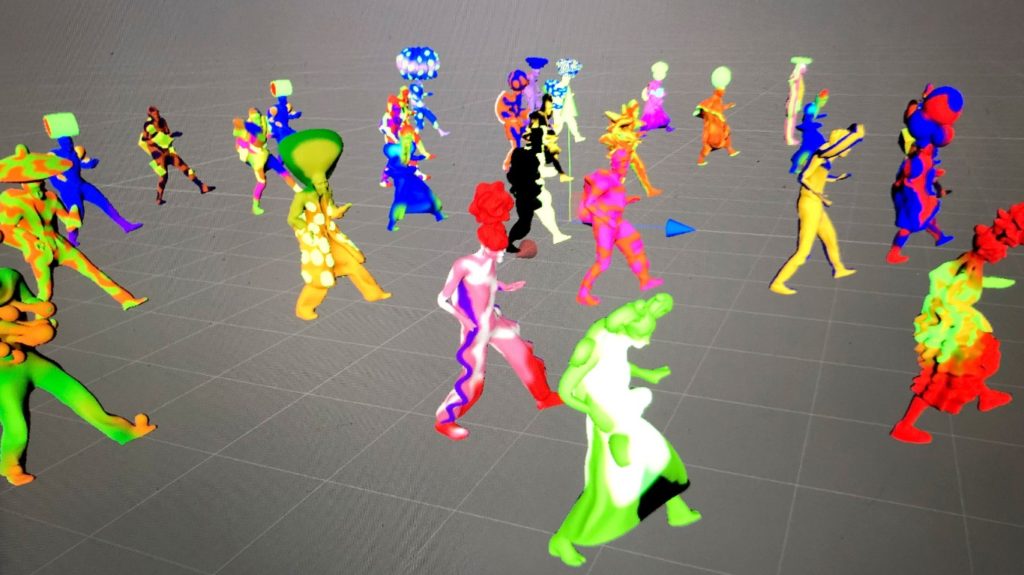
Meet the Artists: Tin & Ed
Stroll through the breezeway on the ground floor of Pier 17 this summer and you might just find yourself in the middle of an impromptu dance party, courtesy of the digital installation We Come in Peace by Tin & Ed.
The piece, which plays every hour on the hour, every day (and Mondays from 7–7:30pm) through July 31st, is the result of Tin & Ed’s insatiable curiosity about the world we live in, how we connect with it, and to each other. The artists and designers, who recently moved to New York, met as students in Melbourne, Australia, 15 years ago and have been creating images, objects and installations together ever since. We Come in Peace, part of the Seaport District’s summer-long Art by the Sea series, is their first major commissioned installation in New York.

What was the genesis of We Come in Peace?
Ed: For us, it’s about responding to a space. Here, that meant thinking about what the Seaport is. It’s got an amazing history.
Tin: It’s like the nectar between the sea and the city. That was interesting for us conceptually. It was also exciting because the Seaport is where New York started—and we’d just arrived as well. There was something poetic about that connection.
Who are the dancing avatars we see?
Tin: These creatures are 3D scans of real people from our travels; there are more than 30 of them in this piece. They’re all incredible, talented people doing amazing things.
Ed: There’s chefs and writers and designers and architects and cyborg artists… We wanted to take the influences of the sea and, in a sense, create new organisms. Like a hybrid human—
Tin: —sea creature! It’s like an underwater dance party. We scan people, then we re-sculpt them taking inspiration from aquatic organisms. We Come in Peace is also a celebration of the amazing creative community in New York. It’s a very celebratory project, especially for it to launch during WorldPride. The people who are involved have creative diversity but all sorts of other diversity, too. And then there’s biodiversity. A lot of our work is about trying to reconnect us back with nature. Thinking of ourselves as being not separate from it, but very much part of it. This project allowed us to find a way to create a balance between us, technology and nature—and bring all those things together.

How do you get your dose of nature living in New York and traveling to cities around the world?
Ed: Trying to get out of the city when we can. The balance is important, whether it’s a short trip upstate or going on a big bush walk in Australia.
Tin: I think it’s hard for everyone to feel that connection sometimes, which is why we’re trying to create work that brings that experience with nature to the city.
Ed: Nature, for us, is the ultimate creator. It’s so imaginative. The influence you can get from it is never-ending. We love exploring that and making parallels between our work and those relationships; the idea of us all being connected. We Come in Peace is about difference and it’s about the individual. How do all these people come together and how do we celebrate their differences?
How do you get your avatars to dance?
Tin: We’re not choreographers so we do as well as we can! After we 3D scan people and sculpt them, we rig them so we can control the bodies. And then we use motion captures of different movements and we cut that up to create new choreography. The moves relate to the different people in some ways, but we also choreographed a way for them to all dance together in unison, so there’s this kind of hive-mind organism.
Ed: We use a real-time game engine to make everything. It’s interesting to use gaming technology and try to do something different with it.
Tin: We’re very interested in emerging technologies as a medium and tool for creating work. Eventually, we’re going to get our own motion capture suits and capture our own motion but for now we’re using sourced motion data.
Ed: Probably not our motion! We’re using a live engine because we want to start doing more interactive stuff, using live data to affect the dancing. One of the reasons we’re so interested in new technology is that it allows for new ways of communicating. One side is the technology: How do we do this? The other is: What do we want to say with it? This technology didn’t exist five or ten years ago. What does that allow us to talk about?

Working with tech must have its challenges. You can’t just call the office IT guy.
Tin: No, it’s a lot of problem solving. And YouTube tutorials! We’ve been teaching ourselves all these new programs and languages.
Ed: Forums are great—I feel like the ultimate nerd when I’m on a forum.
Tin: All that information is out there; you just have to know how to find it. That’s what made this project a reality—engaging with the zeitgeist and the idea that anything is possible.
